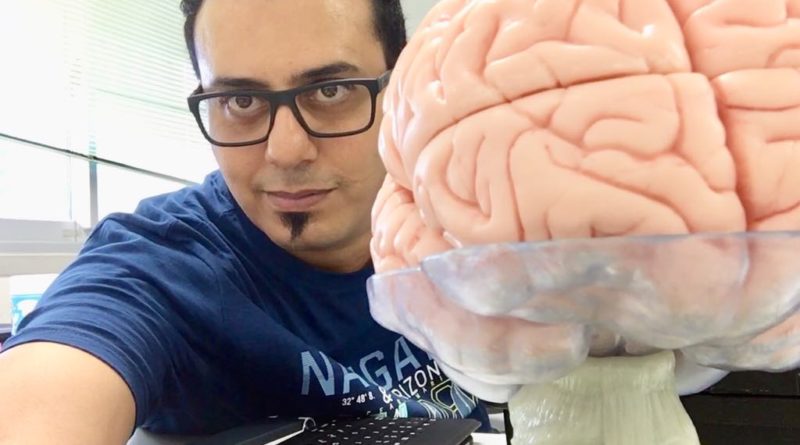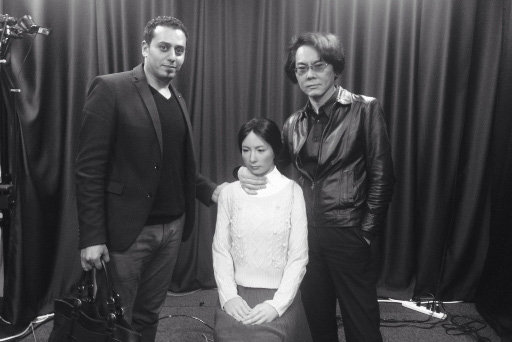From Artificial Intelligence to Neuroscience – Interview With PhD Abd-El-Kader Nasreddine BELKACEM
Reda Mohammed DJABOUR
Abd-el-Kader Nasreddine Belkacem, one of Algeria’s sons whose star is glowing in the world of science. After a record timing of two and a half years spent in hard work and dedication to seeking progress, he was awarded a PhD from the Tokyo Institute of Technology in Japan. A former researcher and an assistant professor at Osaka University; he is currently an Assistant Professor in the Department of Computer and Network engineering in the College of Information Technology – United Arab Emirates University.
1- Instead of following an industrial career you preferred a research career, can you explain to us what derived you to choose this path and especially in brain signals processing?
I became aware of the field of brain machine interface (BMI, the possibility of controlling computer using neural signals) in 2006 during my Magister degree, when a mentor of mine introduced me to the possibilities and strong future prospects for human machine interface. I asked him to supervise my undergraduate project on this topic. Unfortunately, I had neither the knowledge nor the equipment required to realize this dream in Algeria at that time. Because I am something of a dreamer and an optimist though, I became dedicated and enthusiastically committed to pursue research in processing brain waves for control of external devices. I did my best to study English and learn by myself everything about BMIs from the internet (no books in BMI field were available in Algeria at that time), downloading real databases of EEG brain waves for my personal research and experimentation. In this way, I gained a lot of experience and expertise in this field, and was able to obtain a doctoral scholarship award from Japan’s International Cooperation Agency to continue my training with Japanese experts. Once there, I was able to gain experience in recording brain signals myself and I rapidly attained mastery of the experimental techniques. After replicating many researchers’ experiments, I began proposing my own experimental paradigms to discover some new results that may be applied in the real world. I tested many wrong ideas before hitting on the right ones. My last idea of a real-time MEG-based brain-Geminoid interface for enhancing human multitasking ability was in fact inspired by a science fiction movie in which humans were able to control more than four hands using brain activity. After seeing this idea, I began my research in attempting to control humanoid robot hands using brain activity, with the goal of making this science fiction a reality.
2- Your main subject is eye movements and brain machine interface. Could you tell us more about it and what you aim to achieve through it in terms of helping the health system ?
Elon Musk, Facebook, and Microsoft are doing their best to control devices such as personal computers using brain waves for daily use. My ideas can be very helpful to achieve this kind of brain-based technologies. However, my research focuses on innovative neuro-engineering applications for enhancing the performances of brain-machine interfaces. With this technology, the human brain activity can be translated into useful commands to help people with severe motor disabilities control machines and communicate through computers with the outside world.
In 2014, while still working on my PhD, I found a new practical electrode position behind the ear to record eye movements from brain activity (EEG) to improve existing eye-tracking devices and succeeded in controlling a video game in real-time using only thought. This proof of concept has a huge impact on enhancing the performance of many physically challenged people. Furthermore, I proposed the first decoding/control system that distinguishes four bilateral hand movements by using single-trial magnetoencephalography (MEG) signals to control Geminoid (human-like robot) as a new approach to enhance a user’s ability (human multitasking) to interact with a complex environment through a multidimensional BMI.
3- You have published a research paper titled «Neuromagnetic Decoding of Simultaneous Bilateral Hand Movements for Multidimensional Brain-machine Interfaces, IEEE Transactions on Neural Systems and Rehabilitation Engineering (2018)» saying that it could have medical applications. Could you give us an overview of the subject?
This research study was adopted on a cover page of one of the prestigious journals in the biomedical engineering field “IEEE Transactions on Neural Systems and Rehabilitation Engineering, Volume 26, Issue 6, June 2018”. It talks about the possibility of developing multidimensional brain-machine interfaces. Training in multitask processing is known to bring changes and improve brain function. BMI and robotics can thus be used to help workers perform multiple tasks in the same time using their brain activity. In industry, younger workers bring new energy and ideas to the workplace but after working long hours every day, they may become exhausted, stressed, inefficient, and some of them suffer strokes or heart attacks (in Japanese, it’s a condition referred to as Karoshi or “working to death”). My suggestion to alleviate these issues is to increase the multitasking ability in humans by maximizing the brain-control potential, which not only has an engineering interest but also in science.
Intested many wrong ideas before hitting on the right ones.
4- In your opinion, what are the repercussions of artificial intelligence on economics? Precisely, how can it help the algerian market and economy?
Artificial intelligence and all emerging technologies can shape the future of any country. These advanced technologies can create wealth and prosperity for our country if we encourage innovative startups and reinforce the evidence-based practice through R&D everywhere. I do believe that it might be hard to compete with others in developing hardware but it is easier to compete when it comes to developing algorithms and software. However, to achieve my vision, we have to develop mechanisms for shifting our IT infrastructure into the cloud and launching digitalization and e-services for citizens and businesses. In the end, we have to work together. This means increasing collaboration between industry and researchers to find solutions to real-world problems, create jobs and encourage growth.
5- Could you tell us how you managed to coordinate between the needs and requirements of the two fields, AI and neuroscience?
Working on multidisciplinary fields such as brain computer interface requires knowing the basics of signal processing, machine learning, control algorithms, electronics and neuroscience. For PhD students, many things must be learned and developed individually and that’s what I did when I was a PhD student at Tokyo Tech. However, the guiding role of the counseling supervisor is the most important in this stage. After getting your PhD, you may start working on big unsolved questions that may require a multi-disciplinary team of engineers, programmers, medical doctors, and neuroscientists. This kind of team may discover things that have a huge impact on society.
6- What are the obstacles facing the progress of neuroscience in our country?
I have been working on brain-computer interface technology in Japan for several years and it was always a dream for me to bring this technology and transfer my BCI expertise to the Arab world (North Africa and Middle East). This year, I have started teaching this multidisciplinary field to my undergraduate students at the United Arab Emirates University, because the UAE environment supports emerging technologies. In comparison, the problem with research and education in Algeria is complicated. For instance, the government does not support or encourage challenging competitions among researchers nor does it provide healthy R&D environment for them. We still hire incompetent professors (not even having PhD degrees) based on nepotism, unfortunately. We hope this situation will change soon.
7- What strategy would you recommend for the future development of research in Algeria?
We, outstanding researchers and myself, have been working on creating a non-profit organization (a foundation to initiate, support and influence the Algerian Vision for development and sustainable growth). This organization shall work together with the government to set the country’s priorities in different sectors and help establish the grounds for innovation. It will create a platform to deliver many ecosystem projects through a well-designed roadmap of research and development activities.
Artificial intelligence and all emerging technologies can shape the future of any country.


